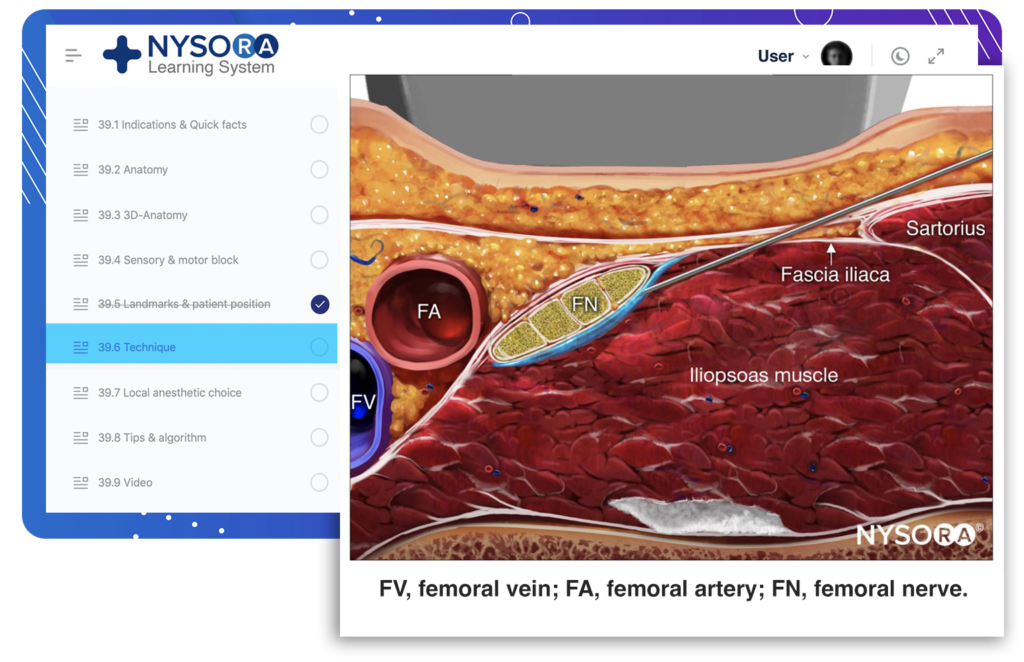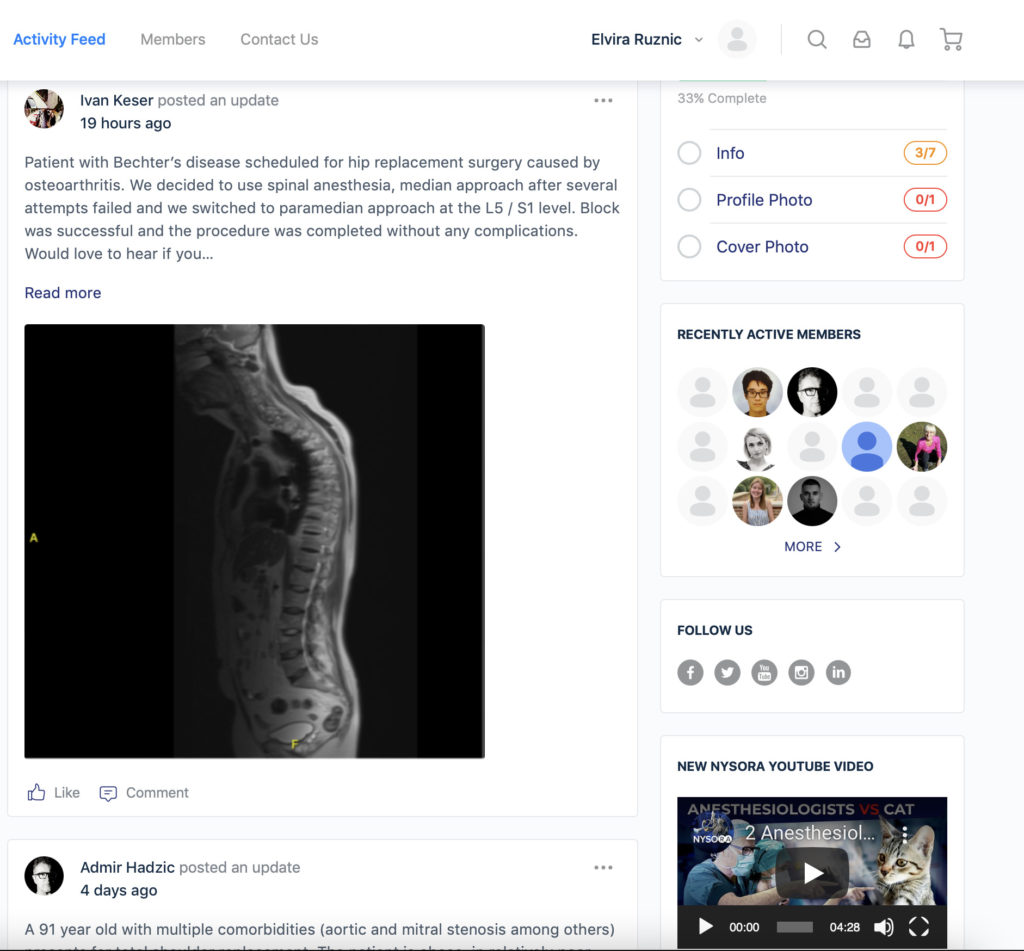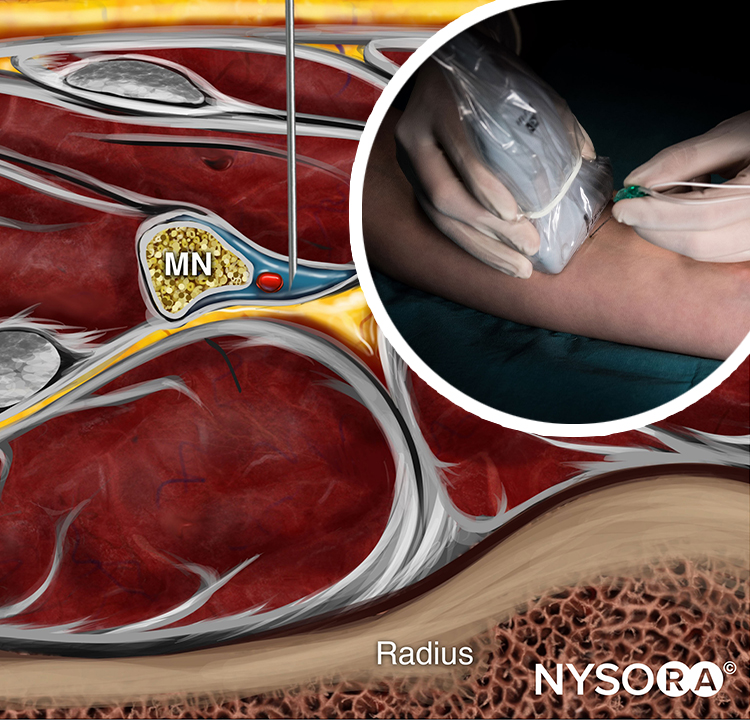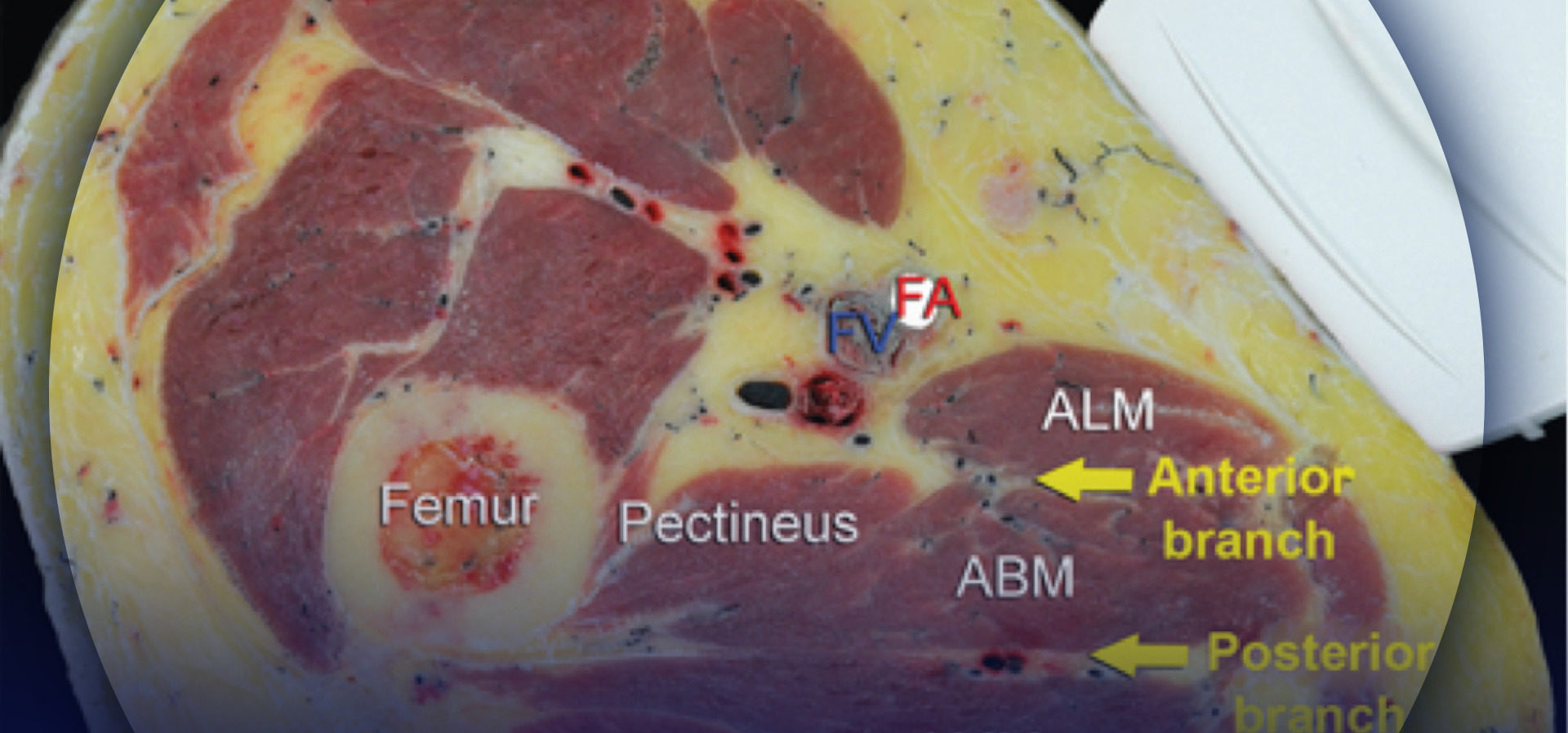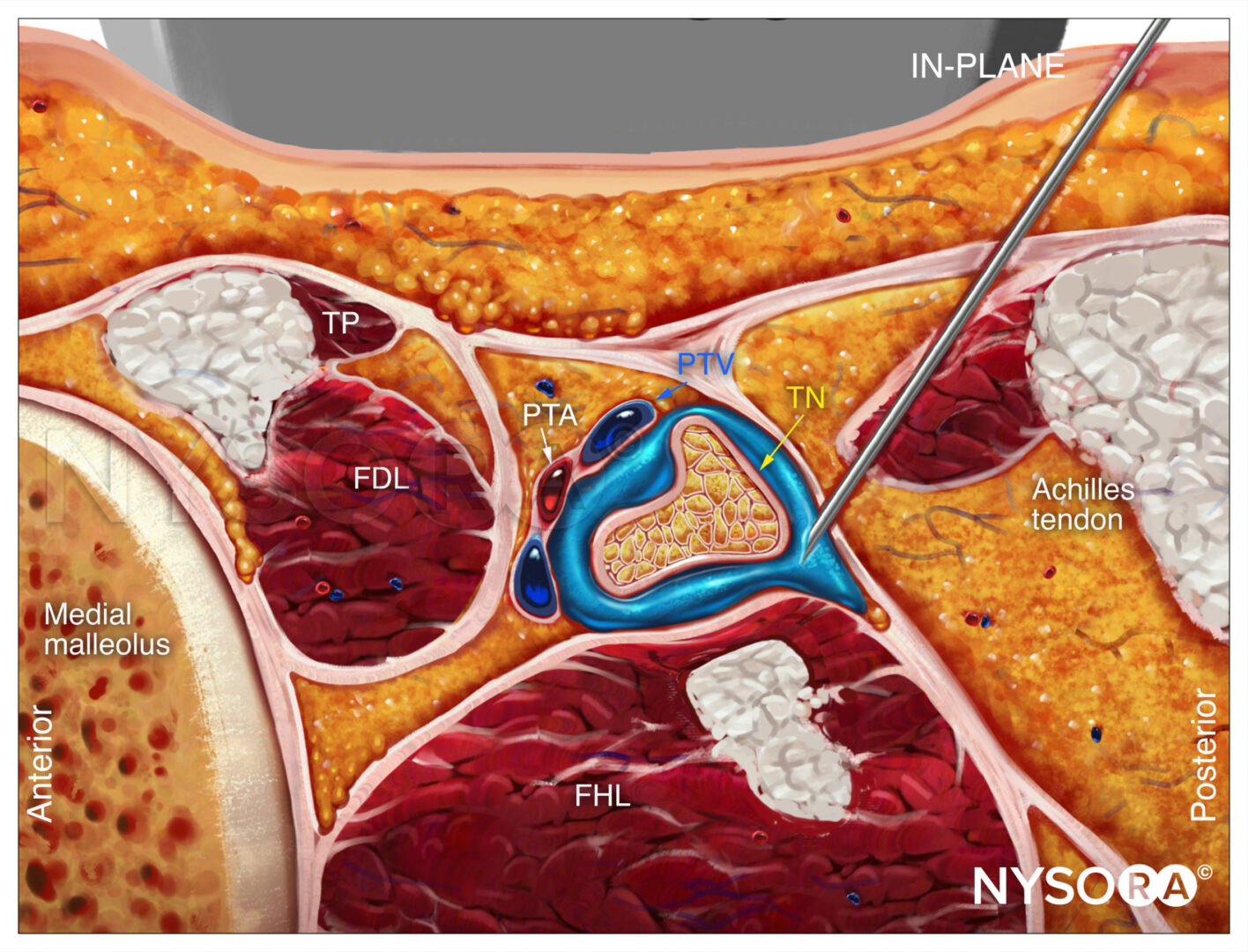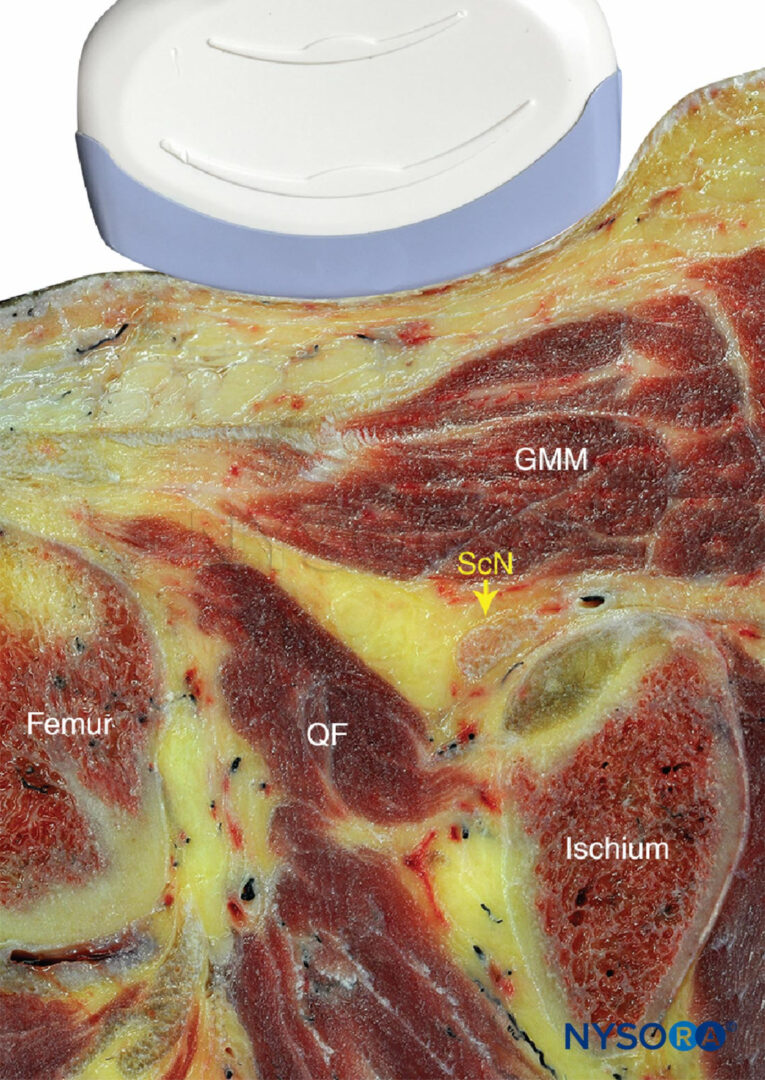Arthur Atchabahian, Ine Leunen, Catherine Vandepitte, and Ana M. Lopez
FACTS
- Indications: Femur, patella, quadriceps tendon, and knee surgery; analgesia for hip fracture
- Transducer position: Transverse, femoral crease
- Goal: Local anesthetic spread adjacent to the femoral nerve
- Local anesthetic: 10–15 mL
GENERAL CONSIDERATIONS
The ultrasound (US)-guided technique of the femoral nerve block allows the practitioner to monitor the spread of local anesthetic and needle placement and make appropriate adjustments to accomplish the desired disposition of the local anesthetic. US also may reduce the risk of femoral artery puncture. Although nerve stimulation is not required for success, motor response observed during nerve stimulation often provides contributory safety information should the needle-nerve relationship be missed by US alone.
ULTRASOUND ANATOMY
Orientation begins with the identification of the femoral artery at the level of the femoral crease. Commonly, the femoral artery and the deep artery of the thigh are both seen. In this case, the transducer should be moved proximally until only the femoral artery is seen (Figure 1a, b). The femoral nerve is lateral to the vessel and covered by the fascia iliaca; it is typically hyperechoic and roughly triangular or oval in shape (Figure 2a, b). The nerve is enveloped within two layers of the fascia iliaca. The femoral nerve typically is visualized at a depth of 2–4 cm.
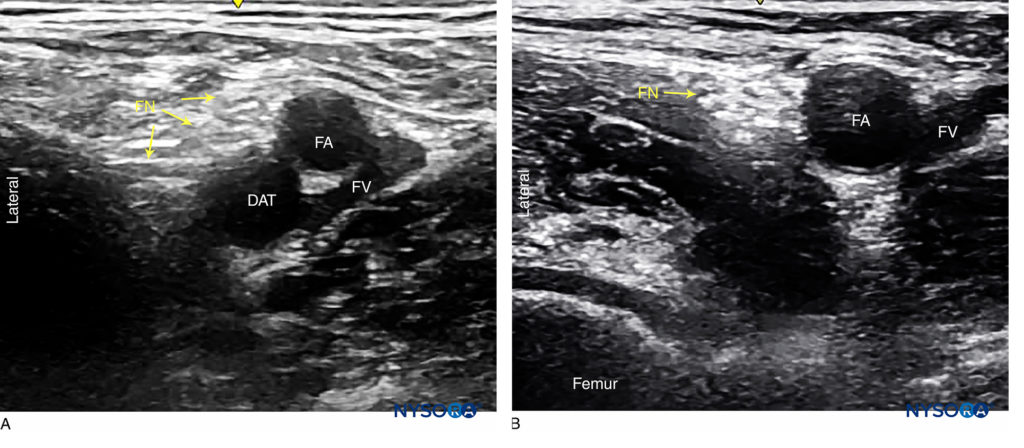
FIGURE 1. Femoral nerve (FN) as seen distally (A) and at the femoral crease (B) Note that FN is better visualized at B, before the take off the deep artery of the thigh (DAT). Femoral vein (FV) is medial to the artery.
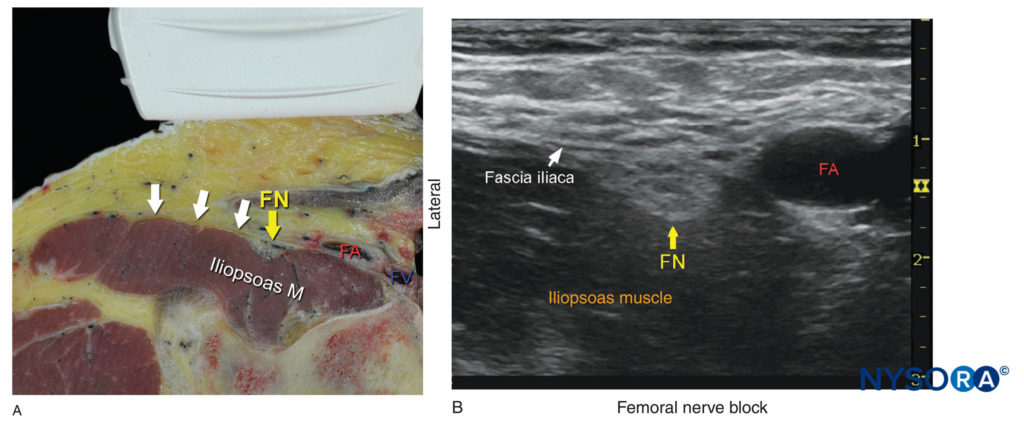
FIGURE 2. (A) Cross-sectional anatomy of the femoral nerve (FN) at the level of the femoral crease. The FN is seen on the surface of the iliopsoas muscle covered by fascia iliaca (white arrows). The femoral artery (FA) and femoral vein (FV) are seen enveloped within their own vascular fascial sheath created by one of the layers of fascia lata. (B) Sonoanatomy of the FN at the femoral triangle. (Reproduced with permission from Hadzic A: Hadzic’s Peripheral Nerve Blocks and Anatomy for Ultrasound-Guided Regional Anesthesia, 2nd ed. New York: McGraw-Hill, Inc.; 2011.)
From the Compendium of Regional Anesthesia: Cognitive priming for a femoral nerve block.
3D ANATOMY
TIPS
- Identification of the femoral nerve often is made easier by slightly tilting the transducer cranially or caudally. This adjustment helps bring out the image of the nerve, making it distinct from the background.
- Applying pressure to the transducer often optimizes the image of the femoral nerve but may collapse veins, obscuring them from the examiner’s eye. The transducer pressure also may compress the interfacial space and interfere with the adequate spread of the local anesthetic. Therefore, the transducer pressure should be released and vasculature re-ascertained before injection.
Read more about Optimizing an Ultrasound Image.
DISTRIBUTION OF ANESTHESIA
Femoral nerve block results in anesthesia of the anterior and medial thigh down to and including the knee, as well as a variable strip of skin on the medial leg and foot. It also innervates the hip, knee, and ankle joints (Figure 3).
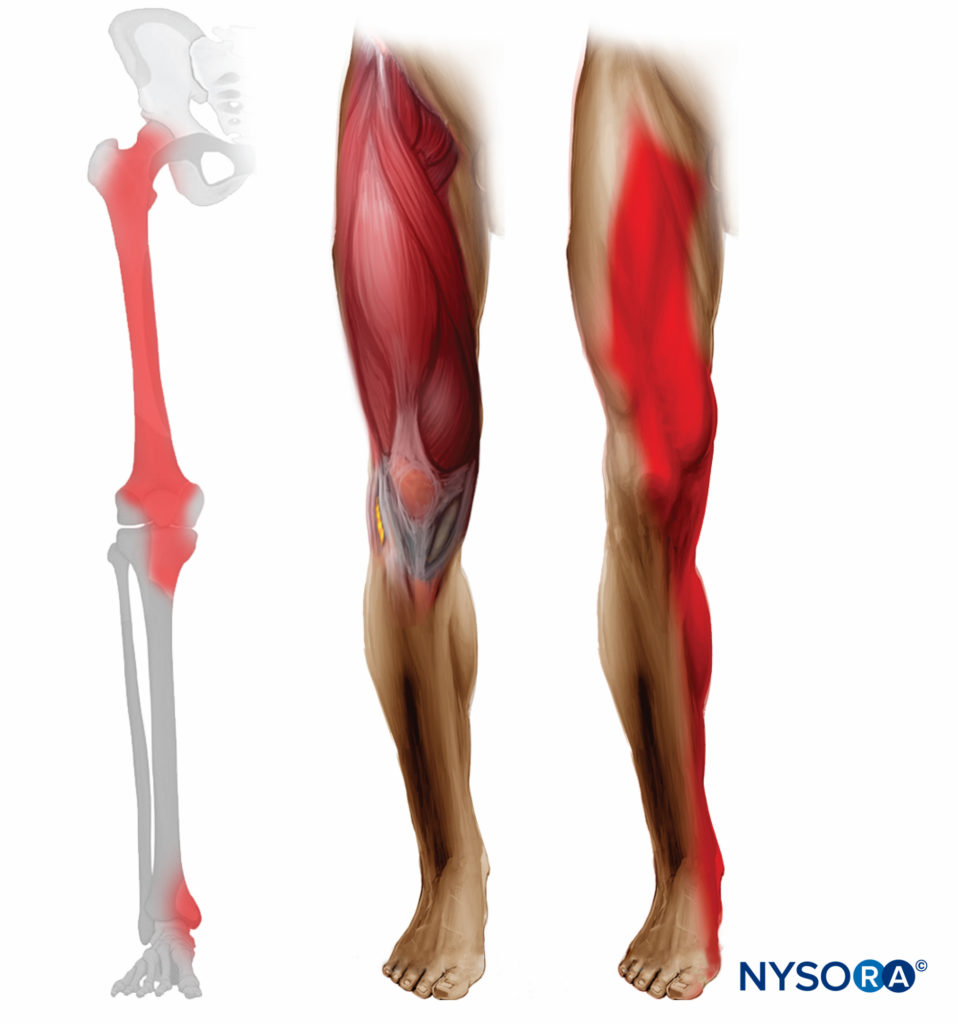
FIGURE 3. Expected distribution of the femoral nerve block. Left -Osteotomal distribution, Right -Dermatomal distribution.
EQUIPMENT
The equipment recommended for a femoral nerve block includes the following:
- Ultrasound machine with linear transducer (8–18 MHz), sterile sleeve, and gel
- Standard nerve block tray
- One 20-mL syringe containing local anesthetic
- A 50- to 100-mm, 22-gauge, short-bevel, insulated stimulating needle
- Peripheral nerve stimulator
- Injection pressure monitor
- Sterile gloves
Learn more about Equipment for Peripheral Nerve Blocks
LANDMARKS AND PATIENT POSITIONING
This nerve block typically is performed with the patient in the supine position, with the bed or table flattened to maximize operator access to the inguinal area. The transducer is placed transversely on the femoral crease, over the pulse of the femoral artery, and moved slowly in a lateral-to-medial direction to identify the artery.
NYSORA Tips
In such cases, using a wide silk tape to retract the abdomen is a useful maneuver prior to skin preparation and scanning (Figure 4).
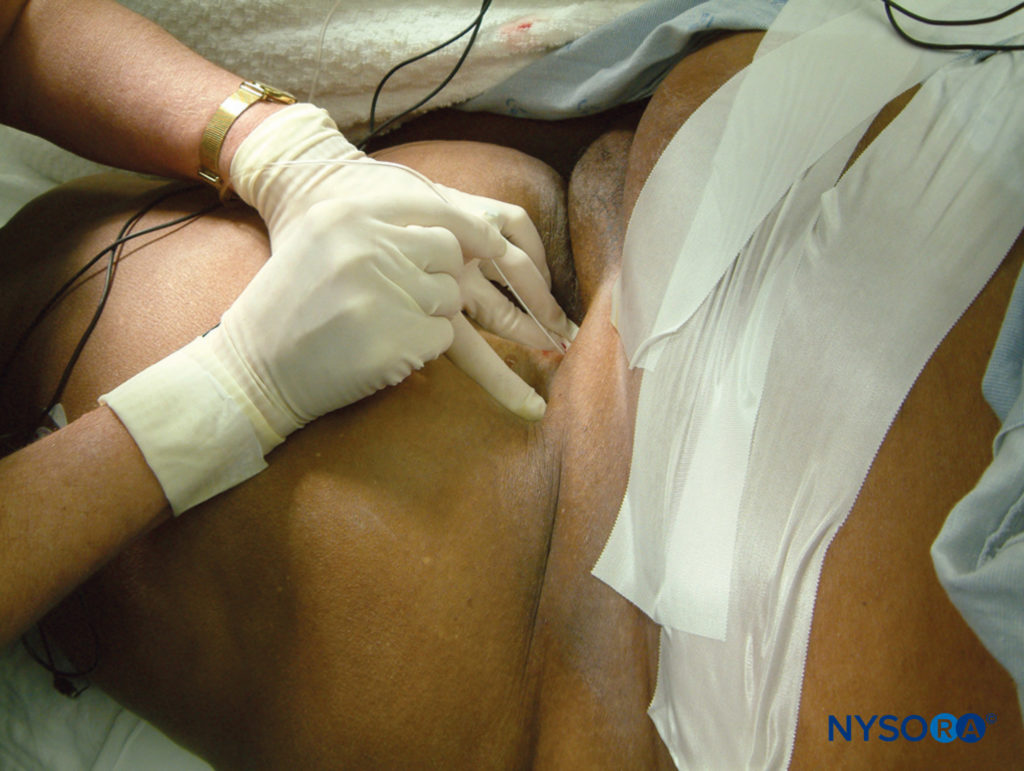
FIGURE 4. Obesity is common in patients who present with an indication for femoral nerve block. Taping the adipose tissue away helps optimize exposure to the femoral crease in patients with morbid obesity.
GOAL
The goal is to place the needle tip immediately adjacent to the lateral aspect of the femoral nerve, below the fascia iliaca or between the two layers of the fascia iliaca, that surround the femoral nerve. Proper deposition of local anesthetic is confirmed either by observation of the femoral nerve being displaced by the injectate or by the spread of the local anesthetic above or below the nerve, surrounding and separating it from the fascia iliaca layers.

From the Compendium of Regional Anesthesia: Reverse Ultrasound Anatomy for a femoral nerve block with needle insertion in-plane and local anesthetic spread (blue). FA, femoral nerve; FV, femoral vein; FN, femoral nerve.
TECHNIQUE
With the patient in the supine position, the skin over the femoral crease is disinfected and the transducer is positioned to identify the femoral artery and nerve. If the nerve is not immediately apparent lateral to the artery, tilting the transducer proximally or distally often helps to image and highlight the nerve from the iliacus muscle and the more superficial adipose tissue. In doing so, an effort should be made to identify the iliacus muscle and its fascia, as well as the fascia lata, because injection underneath a wrong fascial sheath may result in nerve block failure. Once the femoral nerve is identified, a skin wheal of local anesthetic is made 1 cm away from the lateral edge of the transducer. The needle is inserted in-plane in a lateral to medial orientation and advanced toward the femoral nerve (Figure 5).
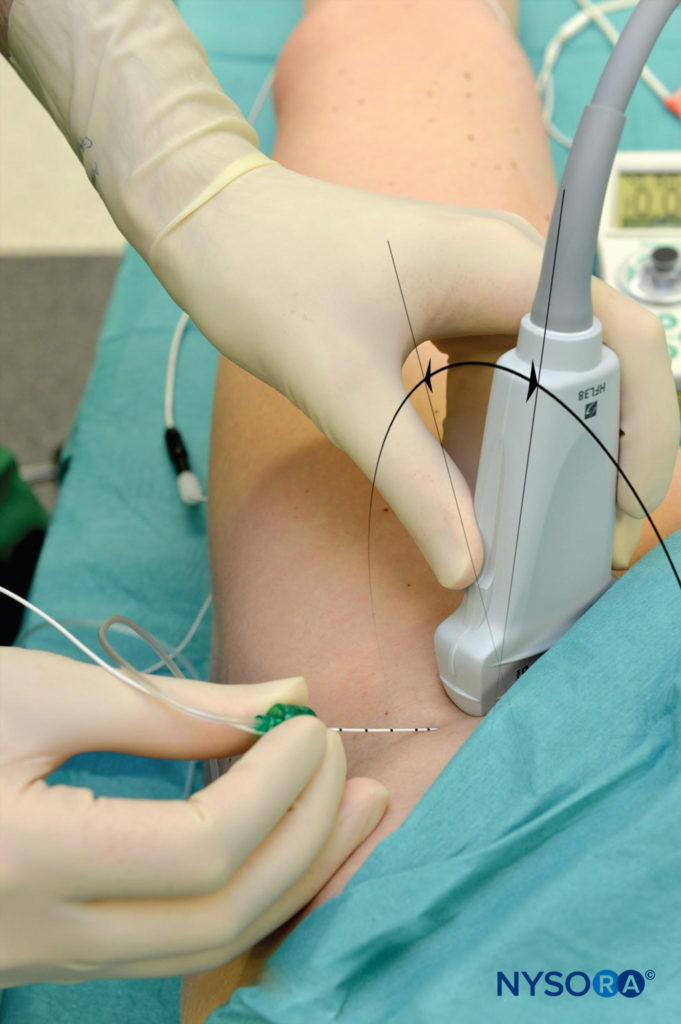
FIGURE 5. Transducer position and needle insertion using an in-plane technique to nerve block the femoral nerve at the femoral crease.
If nerve stimulation is used (0.5 mA, 0.1 msec), the passage of the needle through the fascia iliaca and contact of the needle tip with the femoral nerve usually is associated with a motor response of the quadriceps muscle group. In addition, a needle passage through the fascia iliaca is often felt. Once the needle tip is adjacent (either above, below, or lateral) to the nerve (Figure 6), and after careful aspiration, 1–2 mL of local anesthetic is injected to confirm proper needle placement (Figures 7 and 8). Proper injection will push the femoral nerve away from the injection.
Additional needle repositions and injections are done only when necessary. Anatomic variations have been described with aberrant positions of the femoral nerve. In an adult patient, 10–15 mL of local anesthetic is adequate for a successful nerve block.
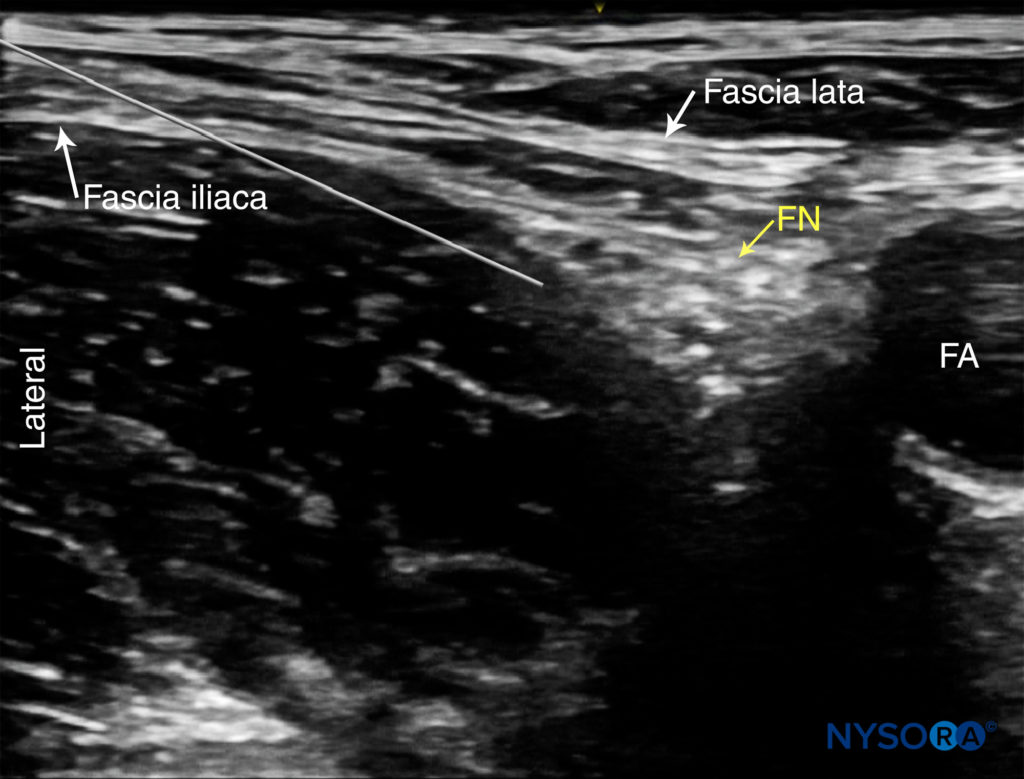
FIGURE 6. Ultrasound image of the needle path to nerve block the femoral nerve. The needle pierces the fascia iliaca lateral to the femoral nerve (FN) and the needle tip is advanced along the deep border of the nerve. FA, femoral artery.
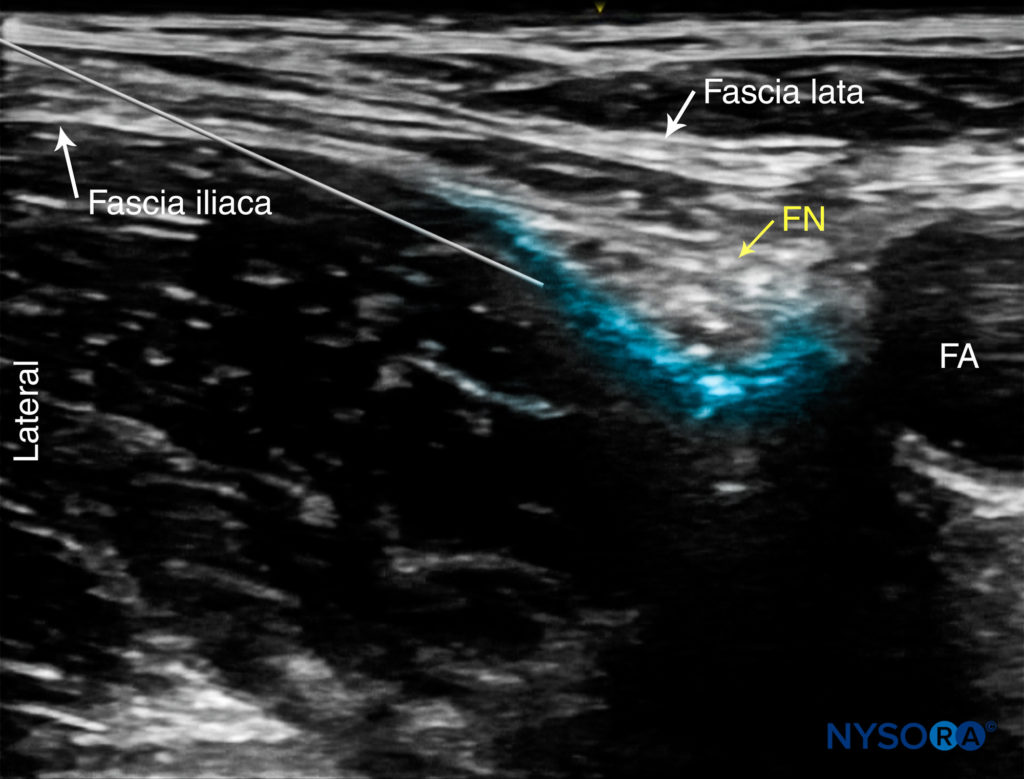
FIGURE 7. Simulated needle path and spread of local anesthetic (blue-shaded area) to nerve block the femoral nerve (FN). FA, femoral artery.
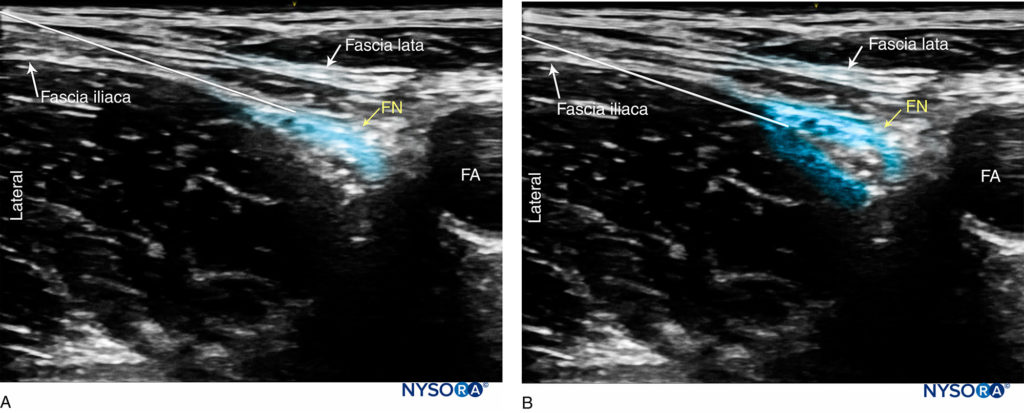
FIGURE 8. Simulated needle paths and local anesthetic spread to nerve block the femoral nerve (FN). (A) The needle tip is advanced in between the fascia iliaca and the nerve and the local anesthetic deposited superficially to the nerve. (B) The tip is located just lateral to the femoral nerve nerve, in between the two layers surrounding the nerve. FA, femoral artery.
TIPS
- Never inject against high resistance to injection because this may signal an intrafascicular needle placement or needle tip position in a wrong fascial plane.
- Circumferential spread of local anesthetic around the nerve is not necessary for this nerve block. A pool of local anesthetic immediately adjacent to either the posterolateral or the anterior aspects is sufficient.
- Locate the femoral vein, releasing pressure on the transducer, using color Doppler if needed. The femoral vein is typically medial to the artery, but it can occasionally lie deep or even lateral to it. It is often compressed by the probe during nerve block performance; being aware of the position of the vein helps decrease the risk of inadvertent intravascular injection.
- Applying forceful pressure to the transducer will compress the tissue below it, making injection more difficult and possibly interfering with the spread between the fascial layers.
- Following hip arthroscopy, landmarks might be displaced by fluid extravasation, with the artery and the nerve significantly deeper than their preoperative position.
CONTINUOUS ULTRASOUND-GUIDED FEMORAL NERVE BLOCK
The goal of the continuous femoral nerve block is the placement of the catheter within the vicinity of the femoral nerve just deep to the fascia iliaca. The procedure consists of five steps: (1) needle placement; (2) injection through the needle to confirm needle placement in the proper tissue plane; (3) catheter advancement; (4) injection through the catheter to assure its therapeutic position; (5) securing the catheter. For the first two phases of the procedure, US can be used to ensure accuracy in most patients. The in-line approach from the lateral-to-medial direction is the most common method because the out-of-plane approach holds greater risk for puncture of the femoral nerve if the needle is introduced directly above the nerve (Figure 9). Alternative approaches, such as the oblique approach, have also been suggested.
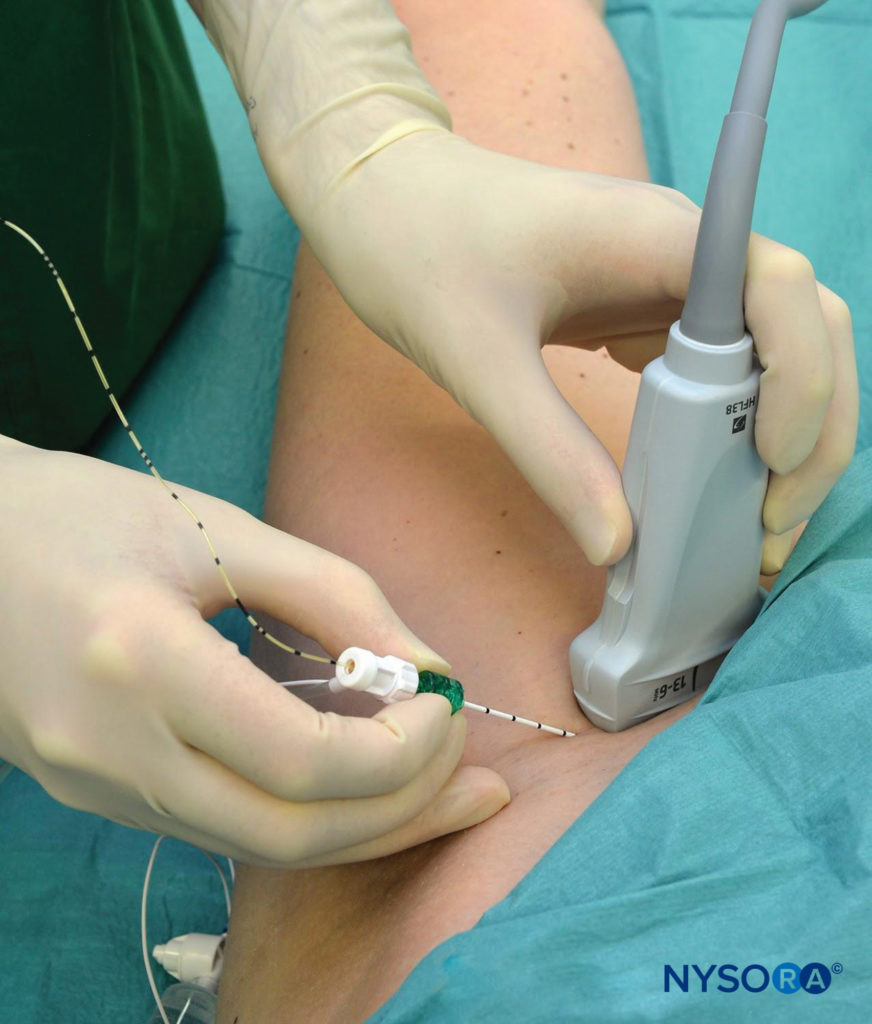
FIGURE 9. Continuous femoral nerve block. The needle is seen inserted in plane approaching the nerve in a lateral-to-medial direction. Although it would seem intuitive that a longitudinal needle insertion would have advantages, the technique demonstrated here is simpler and commonly used. The catheter should be inserted 2–4 cm past the needle tip.
NYSORA Tips
• With US guidance, nonstimulating catheters are used for continuous femoral nerve block. Stimulating catheters require a longer insertion time, without improvement in analgesia. Stimulating catheters also may lead to unnecessary needle and catheter manipulation to obtain the motor response, when in fact the catheter is often in the proper place even when there is no motor response.
• Adequate catheter placement with US guidance is confirmed by disposition of the local anesthetic in the proper anatomical space rather than by motor stimulation.
For a detailed description, please refer to “Continuous US-guided nerve block”.
In general, the inguinal area is quite mobile, and the femoral nerve is shallow, both of which predispose to catheter dislodgment. The more lateral the starting point for needle insertion for continuous femoral nerve block, the longer the catheter would be within the iliacus muscle, which may help prevent dislodgment because muscle tends to stabilize a catheter better than adipose tissue. A common empirical infusion regimen for femoral nerve block in an adult patient is ropivacaine 0.2% at an infusion rate of 5 mL/h with a 5 mL/h patient-controlled bolus.
Read more about Ultrasound-Guided Adductor Canal Nerve Block
Supplementary video related to this block can be found at Ultrasound-Guided Femoral Nerve Block Video
This text was a sample of content from the Compendium of Regional Anesthesia on the NYSORA LMS.
NYSORA’s Compendium of Regional Anesthesia is simply the most comprehensive, and practical curriculum on Regional Anesthesia from A to Z, featuring NYSORA’s Premium content. As opposed to textbooks and e-books, the Compendium is continuously updated and features NYSORA’s newest videos, animations, and visual content.
The Compendium is one of several gold-standard educational courses on NYSORA’s Learning System (the NYSORA LMS), and registration to NYSORALMS.com is free. The FULL access to the Compendium, however, is based on an annual subscription, as it requires an army of illustrators, video editors, and an educational team to continue making it the BEST tool for education on everything regional anesthesia. While you can think of the compendium as an ebook on steroids, a quick test drive will give you a real-time feel of how incredible the Compendium really is. Your subscription will transform the way you read about regional anesthesia:
- Learn visually: Everything regional, including spinal, epidural, and nerve block procedures and management protocols
- Review step-by-step techniques instructions for over 60 nerve blocks
- Access NYSORA’s fabled illustrations, animations, and videos (such as Reverse Ultrasound Anatomy)
- Access RA info on any device via the desktop platform and mobile app
- Get real-time updates
- Review infographics for exam preparation (e.g. EDRA)
- Use the Community feed with real case discussions, images and videos are posted and discussed by subscribers and world’s top experts alike.
Even if you do not wish to subscribe to the Compendium, do register to the NYSORA LMS, be the first to know what’s new in regional anesthesia, and get involved in case discussions.
Here’s what the activity feed on NYSORA LMS looks like:
We are convinced that once you experience the Compendium on the NYSORA LMS, and you’ll never go back to your old books, and your subscription will support keeping NYSORA.com free for the rest of the world.
Additional Reading
- Gurnaney H, Kraemer F, Ganesh A: Ultrasound and nerve stimulation to identify an abnormal location of the femoral nerve. Reg Anesth Pain Med 2009;34:615.
- Chin KJ, Tse C, Chan V: Ultrasonographic identification of an anomalous femoral nerve: the fascia iliaca as a key landmark. Anesthesiology 2011;115:1104.
- Szđcs S, Morau D, Sultan SF, Iohom G, Shorten G: A comparison of three techniques (local anesthetic deposited circumferential to vs. above vs. below the nerve) for ultrasound guided femoral nerve block. BMC Anesthesiol 2014;14:6.
- Muhly WT, Orebaugh SL: Ultrasound evaluation of the anatomy of the vessels in relation to the femoral nerve at the femoral crease. Surg Radiol Anat 2011;33:491–494.
- Hocking G: Anomalous positioning of femoral artery and vein—even “constant” landmarks can be inconsistent. Anaesth Intensive Care 2011;39: 312–313.
- Davis JJ, Swenson JD, Kelly S, Abraham CL, Aoki SK: Anatomic changes in the inguinal region after hip arthroscopy: implications for femoral nerve block. J Clin Anesth 2012;24:590–592.
- Mariano ER, Kim TE, Funck N, et al: A randomized comparison of long-and short-axis imaging for in-plane ultrasound-guided femoral perineural catheter insertion. J Ultrasound Med 2013;32:149–156.
- Fredrickson MJ, Danesh-Clough TK; Ultrasound-guided femoral catheter placement: a randomised comparison of the in-plane and out-of-plane techniques. Anaesthesia 2013;68:382–390.
- Wang AZ, Gu L, Zhou QH, Ni WZ, Jiang W: Ultrasound-guided continuous femoral nerve block for analgesia after total knee arthroplasty: catheter perpendicular to the nerve versus catheter parallel to the nerve. Reg Anesth Pain Med 2010;35:127–131.
- Fredrickson M: “Oblique” needle-probe alignment to facilitate ultrasound-guided femoral catheter placement. Reg Anesth Pain Med 2008;33: 383–384.
- Farag E, Atim A, Ghosh R, et al: Comparison of three techniques for ultrasound-guided femoral nerve catheter insertion: a randomized, blinded trial. Anesthesiology 2014;121:239–248.
- Gandhi K, Lindenmuth DM, Hadzic A, et al: The effect of stimulating versus conventional perineural catheters on postoperative analgesia following ultrasound-guided femoral nerve localization. J Clin Anesth 2011;23:626–631.
- Altermatt FR, Corvetto MA, Venegas C, et al: Brief report: the sensitivity of motor responses for detecting catheter-nerve contact during ultrasound-guided femoral nerve blocks with stimulating catheters. Anesth Analg 2011;113:1276–1278.
Single-Injection Femoral Nerve Block
- Ajmal M, Power S, Smith T, Shorten GD: Ergonomic task analysis of ultrasound-guided femoral nerve block: a pilot study. J Clin Anesth 2011;23:35–41.
- Bech B, et al. The successful use of peripheral nerve blocks for femoral amputation. Acta Anaesthesiol Scand 2009;53:257–260.
- Brull R, Prasad GA, Gandhi R, Ramlogan R, Khan M, Chan VW: Is a patella motor response necessary for continuous femoral nerve block performed in conjunction with ultrasound guidance? Anesth Analg 2011;112:982–986.
- Casati A, Baciarello M, Di Cianni S, et al: Effects of ultrasound guidance on the minimum effective anaesthetic volume required to nerve block the femoral nerve. Br J Anaesth 2007;98:823–827.
- Dold AP, Murnaghan L, Xing J, Abdallah FW, Brull R, Whelan DB: Preoperative femoral nerve block in hip arthroscopic surgery: a retrospective review of 108 consecutive cases. Am J Sports Med 2014;42:144–149.
- Forget P: Bad needles can’t do good nerve blocks. Reg Anesth Pain Med 2009;34:603. Fredrickson MJ, Kilfoyle DH: Neurological complication analysis of 1000 ultrasound guided peripheral nerve blocks for elective orthopaedic surgery: a prospective study. Anaesthesia 2009;64:836–844.
- Gupta PK, Chevret S, Zohar S, Hopkins PM: What is the ED95 of prilocaine for femoral nerve block using ultrasound? Br J Anaesth 2013;110: 831–836.
- Hadzic A, Houle TT, Capdevila X, Ilfeld BM: Femoral nerve block for analgesia in patients having knee arthroplasty. Anesthesiology 2010; 113:1014–1015.
- Helayel PE, da Conceição DB, Feix C, Boos GL, Nascimento BS, de Oliveira Filho GR: Ultrasound-guided sciatic-femoral nerve block for revision of the amputation stump. Case report. Rev Bras Anestesiol 2008;58:480–482,482–484.
- Hotta K, Sata N, Suzuki H, Takeuchi M, Seo N: Ultrasound-guided combined femoral nerve and lateral femoral cutaneous nerve blocks for femur neck fracture surgery—case report [in Japanese]. Masui 2008;57:892–894.
- Ishiguro S, Asano N, Yoshida K, et al: Day zero ambulation under modified femoral nerve block after minimally invasive surgery for total knee arthroplasty: preliminary report. J Anesth 2013;27:132–134.
- Ishiguro S, Yokochi A, Yoshioka K, et al: Technical communication: anatomy and clinical implications of ultrasound-guided selective femoral nerve block. Anesth Analg 2012;115:1467–1470.
- Ito H, Shibata Y, Fujiwara Y, Komatsu T: Ultrasound-guided femoral nerve block [in Japanese]. Masui 2008;57:575–579.
- Lang SA: Ultrasound and the femoral three-in-one nerve block: weak methodology and inappropriate conclusions. Anesth Analg 1998;86:1147–1148.
- Marhofer P, Harrop-Griffiths W, Willschke H, Kirchmair L: Fifteen years of ultrasound guidance in regional anaesthesia: part 2—recent developments in block techniques. Br J Anaesth 2010;104:673–683.
- Marhofer P, Nasel C, Sitzwohl C, Kapral S: Magnetic resonance imaging of the distribution of local anesthetic during the three-in-one block. Anesth Analg 2000;90:119–124.
- Marhofer P, Schrögendorfer K, Koinig H, Kapral S, Weinstabl C, Mayer N: Ultrasonographic guidance improves sensory block and onset time of three-in-one blocks. Anesth Analg 1997;85:854–857.
- Mariano ER, Loland VJ, Sandhu NS, et al: Ultrasound guidance versus electrical stimulation for femoral perineural catheter insertion. J Ultrasound Med 2009;28:1453–1460.
- Murray JM, Derbyshire S, Shields MO: Lower limb blocks. Anaesthesia 2010; 65(Suppl 1):57–66.
- Oberndorfer U, Marhofer P, Bösenberg A, et al: Ultrasonographic guidance for sciatic and femoral nerve blocks in children. Br J Anaesth 2007;98: 797–801.
- O’Donnell BD, Mannion S: Ultrasound-guided femoral nerve block, the safest way to proceed? Reg Anesth Pain Med 2006;31:387–388.
- Reid N, Stella J, Ryan M, Ragg M: Use of ultrasound to facilitate accurate femoral nerve block in the emergency department. Emerg Med Australas 2009;21:124–130.
- Salinas FV: Ultrasound and review of evidence for lower extremity peripheral nerve blocks. Reg Anesth Pain Med 2010;35(Suppl 2):S16–25.
- Schafhalter-Zoppoth I, Moriggl B: Aspects of femoral nerve block. Reg Anesth Pain Med 2006;31:92–93.
- Sites BD, Beach M, Gallagher JD, Jarrett RA, Sparks MB, Lundberg CJ: A single injection ultrasound-assisted femoral nerve block provides side effect-sparing analgesia when compared with intrathecal morphine in patients undergoing total knee arthroplasty. Anesth Analg 2004;99:1539–1543.
- Sites BD, Beach ML, Chinn CD, Redborg KE, Gallagher JD: A comparison of sensory and motor loss after a femoral nerve block conducted with ultrasound versus ultrasound and nerve stimulation. Reg Anesth Pain Med 2009;34:508–513.
- Soong J, Schafhalter-Zoppoth I, Gray AT: The importance of transducer angle to ultrasound visibility of the femoral nerve. Reg Anesth Pain Med 2005;30:505.
- Szucs S, Morau D, Iohom G: Femoral nerve block. Med Ultrason 2010; 12:139–144.
- Tran DQ, Muñoz L, Russo G, Finlayson RJ: Ultrasonography and stimulating perineural catheters for nerve blocks: a review of the evidence. Can J Anaesth 2008;55:447–457.
- Tsui B, Suresh S: Ultrasound imaging for regional anesthesia in infants, children, and adolescents: a review of current literature and its application in the practice of extremity and trunk blocks. Anesthesiology 2010;112:473–492.
- Watson MJ, Walker E, Rowell S, et al: Femoral nerve block for pain relief in hip fracture: a dose finding study. Anaesthesia 2014;69:683–686.
Continuous Femoral Nerve Block
- Albrecht E, Morfey D, Chan V, et al: Single-injection or continuous femoral nerve block for total knee arthroplasty? Clin Orthop Relat Res 2014;472:1384–1393.
- Aveline C, Le Roux A, Le Hetet H, Vautier P, Cognet F, Bonnet F: Postoperative efficacies of femoral nerve catheters sited using ultrasound combined with neurostimulation compared with neurostimulation alone for total knee arthroplasty. Eur J Anaesthesiol 2010;27:978–984.
- Capdevila X, Biboulet P, Morau D, et al: Continuous three-in-one block for postoperative pain after lower limb orthopedic surgery: where do the catheters go? Anesth Analg 2002;94:1001–1006.
- Eledjam JJ, Cuvillon P, Capdevila X, et al: Postoperative analgesia by femoral nerve block with ropivacaine 0.2% after major knee surgery: continuous versus patient-controlled techniques. Reg Anesth Pain Med 2002;27:604–611.
- Errando CL: Ultrasound-guided femoral nerve block: catheter insertion in a girl with skeletal abnormalities [in Spanish]. Rev Esp Anestesiol Reanim 2009;56:197–198.
- Fredrickson MJ, Danesh-Clough TK: Ambulatory continuous femoral analgesia for major knee surgery: a randomised study of ultrasoundguided femoral catheter placement. Anaesth Intensive Care 2009;37:758–766.
- Gandhi K, Lindenmuth DM, Hadzic A, et al: The effect of stimulating versus conventional perineural catheters on postoperative analgesia following ultrasound-guided femoral nerve localization. J Clin Anesth 2011;23:626–631.
- Koscielniak-Nielsen ZJ, Rasmussen H, Hesselbjerg L: Long-axis ultrasound imaging of the nerves and advancement of perineural catheters under direct vision: a preliminary report of four cases. Reg Anesth Pain Med 2008;33:477–482.
- Niazi AU, Prasad A, Ramlogan R, Chan VWS: Methods to ease placement of stimulating catheters during in-plane ultrasound-guided femoral nerve block. Reg Anesth Pain Med 2009;34:380–381.
- Villegas Duque A, Ortiz de la Tabla González R, Martínez Navas A, Echevarría Moreno M: Continuous femoral block for postoperative analgesia in a patient with poliomyelitis [in Spanish]. Rev Esp Anestesiol Reanim 2010;57:123–124.
- Wasserstein D, Farlinger C, Brull R, Mahomed N, Gandhi R: Advanced age, obesity and continuous femoral nerve block are independent risk factors for inpatient falls after primary total knee arthroplasty. J Arthroplasty 2013;28:1121–1124.
